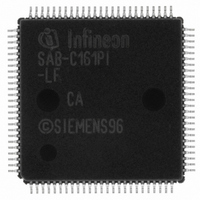SAB-C161PI-LF CA Infineon Technologies, SAB-C161PI-LF CA Datasheet - Page 28

SAB-C161PI-LF CA
Manufacturer Part Number
SAB-C161PI-LF CA
Description
IC MICROCONTROLLER 16BIT 100TQFP
Manufacturer
Infineon Technologies
Series
C16xxr
Datasheet
1.SAF-C161PI-LM_CA.pdf
(82 pages)
Specifications of SAB-C161PI-LF CA
Core Processor
C166
Core Size
16-Bit
Speed
20MHz
Connectivity
EBI/EMI, I²C, SPI, UART/USART
Peripherals
POR, PWM, WDT
Number Of I /o
76
Program Memory Type
ROMless
Ram Size
3K x 8
Voltage - Supply (vcc/vdd)
4.5 V ~ 5.5 V
Data Converters
A/D 4x10b
Oscillator Type
Internal
Operating Temperature
0°C ~ 70°C
Package / Case
100-LFQFP
Packages
PG-TQFP-100
Max Clock Frequency
20.0 MHz
Sram (incl. Cache)
3.0 KByte
A / D Input Lines (incl. Fadc)
4
Program Memory
0.0 KByte
Lead Free Status / RoHS Status
Lead free / RoHS Compliant
Eeprom Size
-
Program Memory Size
-
Other names
B161PILFCAXT
SAB-C161PI-LF CA
SAB-C161PI-LFCAINTR
SABC161PILFCAXT
SP000014344
SAB-C161PI-LF CA
SAB-C161PI-LFCAINTR
SABC161PILFCAXT
SP000014344
&3,
Serial Channels
Serial communication with other microcontrollers, processors, terminals or external
peripheral components is provided by two serial interfaces with different functionality, an
Asynchronous/Synchronous Serial Channel (ASC0) and a High-Speed Synchronous
Serial Channel (SSC).
The ASC0 is upward compatible with the serial ports of the Infineon 8-bit microcontroller
families and supports full-duplex asynchronous communication at up to 780 KBaud and
half-duplex synchronous communication at up to 3.1 MBaud @ 25 MHz CPU clock.
A dedicated baud rate generator allows to set up all standard baud rates without
oscillator tuning. For transmission, reception and error handling 4 separate interrupt
vectors are provided. In asynchronous mode, 8- or 9-bit data frames are transmitted or
received, preceded by a start bit and terminated by one or two stop bits. For
multiprocessor communication, a mechanism to distinguish address from data bytes has
been included (8-bit data plus wake up bit mode).
In synchronous mode, the ASC0 transmits or receives bytes (8 bits) synchronously to a
shift clock which is generated by the ASC0. The ASC0 always shifts the LSB first. A loop
back option is available for testing purposes.
A number of optional hardware error detection capabilities has been included to increase
the reliability of data transfers. A parity bit can automatically be generated on
transmission or be checked on reception. Framing error detection allows to recognize
data frames with missing stop bits. An overrun error will be generated, if the last
character received has not been read out of the receive buffer register at the time the
reception of a new character is complete.
The SSC supports full-duplex synchronous communication at up to 6.25 Mbaud @
25 MHz CPU clock. It may be configured so it interfaces with serially linked peripheral
components. A dedicated baud rate generator allows to set up all standard baud rates
without oscillator tuning. For transmission, reception and error handling 3 separate
interrupt vectors are provided.
The SSC transmits or receives characters of 2...16 bits length synchronously to a shift
clock which can be generated by the SSC (master mode) or by an external master (slave
mode). The SSC can start shifting with the LSB or with the MSB and allows the selection
of shifting and latching clock edges as well as the clock polarity.
A number of optional hardware error detection capabilities has been included to increase
the reliability of data transfers. Transmit and receive error supervise the correct handling
of the data buffer. Phase and baudrate error detect incorrect serial data.
Data Sheet
26
1999-07












